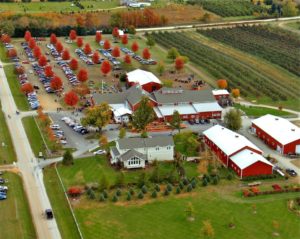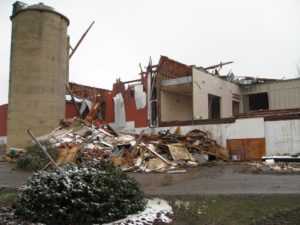Ken Hall On Building Projects: View Local Boards As Team Members, Not Enemies

When a tornado destroyed Winnebago,IL-based Edwards Apple Orchard’s farm market barns in 2008, owner Ken Hall held a day-long retreat with everyone who might have a say in the rebuilding project, from employees to the fire marshal to regulators.
Usually, when a grower faces a major building project, he dreads all the hoops he’ll need to jump through. But Hall believes that thinking is backwards. It’s better by far, he says, to view everyone involved as partners with something to contribute.
Before getting into how Hall managed to win the cooperation of his local governing bodies and managed to rebuild within months, in time for his main season, let’s take a look at what Hall, his wife, and the Edwards Apple Orchard faced at the beginning of the project.
“A tornado in the spring of 2008 took down all the buildings, and came right through our farm stead,” Hall says.
Before the tornado, he had a mix of buildings and barns, all close together, with the oldest dating from 1860. He wanted to recreate the atmosphere and appeal those historical structures gave his business, including the nooks and crannies.
For many, the more specific you make your wish list is for a new building project, the more headaches you encounter in getting permits and passing inspections.
But Hall had an ace in his pocket along with his positive outlook: his architect.
“My architect is a customer and knew what we were trying to do,” Hall says.
 The architect suggested a meeting of minds before getting started, and Hall took him at his word.
The architect suggested a meeting of minds before getting started, and Hall took him at his word.
“I invited anyone I thought might have opinions on what we were trying to do — health, zoning, the fire chief, all our employees, local politicians, the state attorney’s office, the sheriff’s office.
Three weeks after the tornado, the group got together, lead by Hall’s architect. They talked about what the plan might be, what they were working with, and where they wanted to go. This kind of meeting is referred to a cherrette, Hall says, a meeting of minds of all stakeholders in a project.
“We broke up into groups, with about 10 to 12 tables. Some of the meetings were staff, some were regulators, and everyone talked about what they wanted to see happen. We then compared it all,” Hall says. “It was an empowering experience for our employees and regulators.”
The meeting bore fruit. With everyone aligned, they were able to move quickly. They were even allowed to build the foundation before all the paper work was finalized, something that was vital to reopening in time for the fall season.
“Reopened a week late that year, with brand new “old” buildings,” Hall says.
The rebuild gave Hall the chance to correct issues had with those old buildings, as charming as they were.
“We’d outgrown our plumbing and electrical systems, and needed a new bathroom. We expanded the bakery and expanded the septic system,” he says.
Insurance only covered $400,000 of the rebuild, with was $3.5 million (which Hall paid off in September of 2015). He could have done a less expensive build, but the experience of shopping at Edwards Apple Orchard is key to the future of the business in Hall’s mind.
If you are considering expanding your farm market, take a page from Hall’s playbook and recruit your local inspectors to be on your team.
“When other growers complain about that kind of thing (zoning), I tell them you have to change how you think and think of them as a team member — they’re trying to prevent sickness and improve safety. Don’t think of them as opponents. That’s a really key thing. We couldn’t have done it without them,” Hall says.









